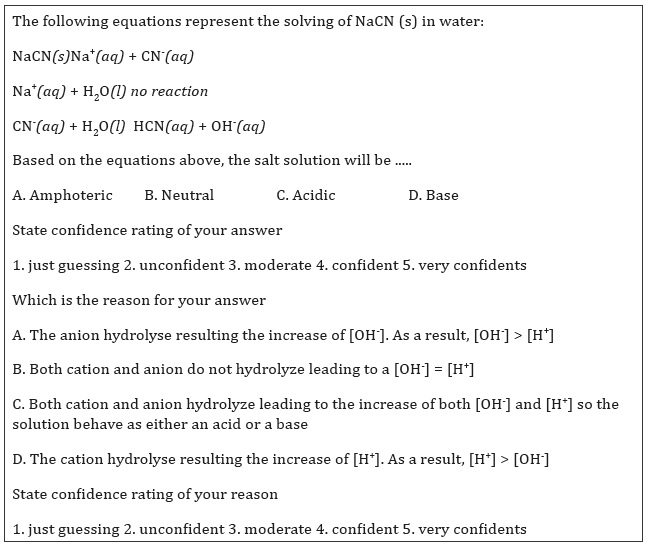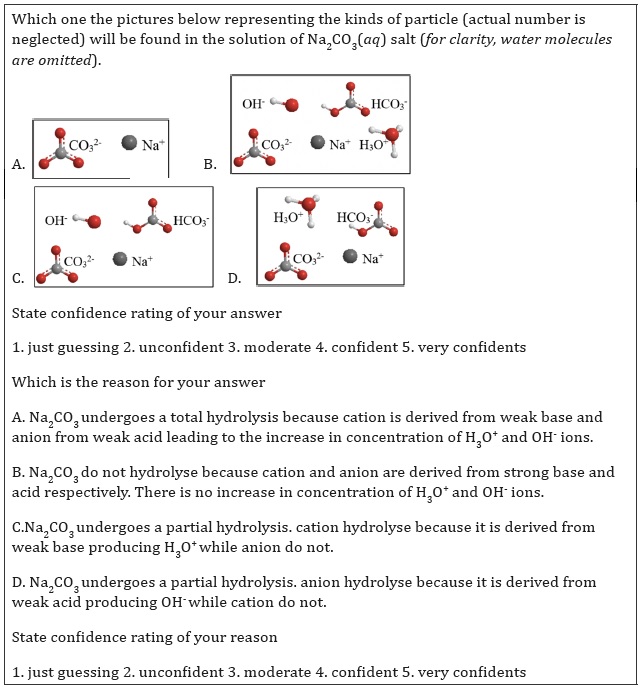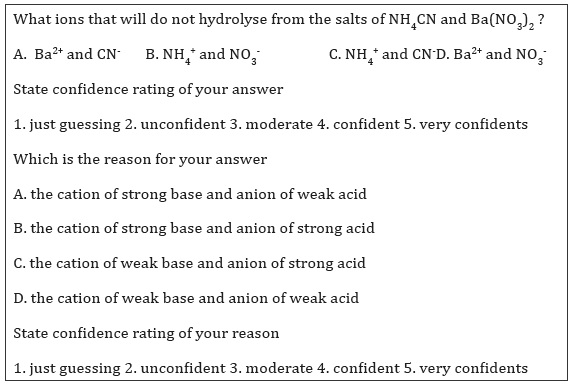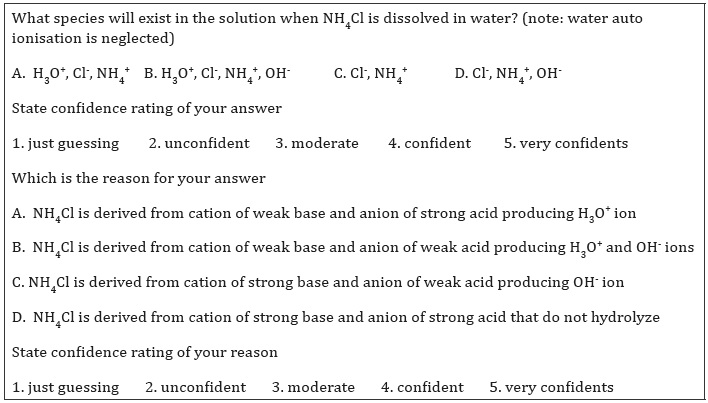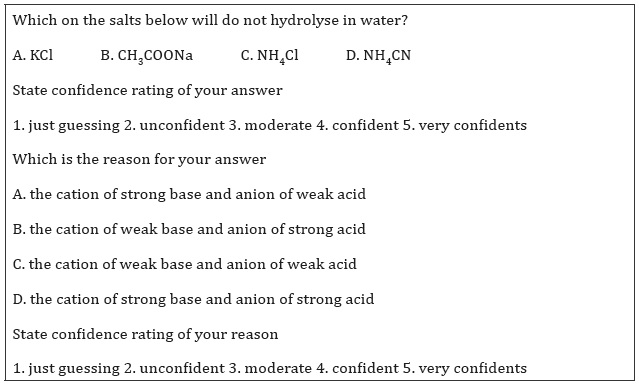Introduction
Studies of students’ unscientific understanding have been a concern for science, including chemistry educator, for some decades. However, similar studies currently uncover several unscientific understandings harboured by students in secondary and tertiary levels. In the area of chemical kinetics, for example, an unscientific understanding that “the increase in temperature increases the rate of endothermic reaction but decreases the exothermic one” has been revealed since Hackling & Garnet (Hackling & Garnett, 1985) to Kirik & Boz (Kirik & Boz, 2012). This unscientific understanding was also revealed in the recent study involving Indonesian and UK students (Habiddin, 2018).
In the topic of acid-base properties of salt solution, the misunderstanding that “salt produced from a neutralisation reaction always has pH 7” has been uncovered by many authors (Hoe & Subramaniam, 2016; Schmidt & Chemie, 1995; Sesen & Tarhan, 2011; Zoller, 1990). Therefore, many research studies are only terminated in the scientific papers without further implementation in the actual teaching. This phenomenon could be rooted in those studies describing the unscientific understandings only without seeking the essential factor of the unscientific understanding.
A scientific paper proposing a fruitful approach to teach acid-base properties of salt solution is found from the work of Aquirre-Ode (1987). Similar work following this paper has not been found. In addition, the paper has discussed the approach in a fundamental theoretical manner. However, the pedagogical aspect of teaching the topic which is applicable for chemistry teacher was unclear. Therefore, a study exploring students’ misunderstanding in acid-base properties of salt solution is necessary because knowledge of students’ preconception before embarking on new teaching is still of value (Pan & Henriques, 2015). Studies on students’ unscientific understanding have been of concern for years.
Meanwhile, the equivalent study portraying students’ scientific understanding is limited. This study aimed to uncover students scientific understanding and unscientific understanding in the topic of acid-base properties of salt solution. This study could be informed to improve the quality of chemistry teaching in the relevant topic.
Students’ understanding in this study was investigated using a Four-tier instrument in the topic of salt hydrolysis (FTISH). This kind of instrument has been widely applied in the area of science education. The separated confidence rating for answer tier and reason tier ensure the certainty in grading students’ confidence accurately (Gurel et al., 2015; Sreenivasulu & Subramaniam, 2014). Employing a four-tier format is useful for chemistry teachers because the instrument could provide the expected results rapidly. (Habiddin & Page, 2019). The typical instrument has been proved to be useful in identifying students’ understanding in several chemistry areas, including chemical kinetics (Habiddin & Page, 2019; Yan & Subramaniam, 2018), thermodynamics (Sreenivasulu & Subramaniam, 2013) and transition-metal chemistry (Sreenivasulu & Subramaniam, 2014).
Literature review
Students’ incorrect conception has been attributed to several different terminologies, including misunderstanding, alternative conception, unscientific understanding, alternative frameworks, misconception, misinterpretation, and erroneous ideas. The term unscientific understanding is preferred in this paper, considering that the phrase unscientific purely reflects the nature of the incorrect conception. Since most science education literature uses the term ‘misconception,’ the two terminologies (unscientific understanding and misconception) are used interchangeably in this paper to avoid excessive repetition in language.
The instrument for assessment procedure is an essential element in education (Stojanovska & Petruševski, 2017). A misconception is commonly resistant and demanding to be changed with the new information, which is scientific given in the class. Therefore, investigating students’ unscientific understanding as early as possible is essential to improve the quality of science teaching (Kirik & Boz, 2012) as waiting for an apparent insight of teaching problems to be coped with could be too late exercise (Majer et al., 2019).
Methods
1. Participants
This descriptive quantitative study involved 300 students from 3 public secondary schools (out of 9 public secondary schools) in Malang, East Java, Indonesia. Malang is the secondlargest city in the Province of East Java and famous for its educational culture. It has been a favourite destination for many students around the state to continue their study, particularly for whom pursuing bachelor to doctoral degrees. Secondary school students from this area consistently show a high performance in the annual national examination and several national academic competitions such as National Chemistry Olympiad. The three schools represent all secondary school grades (both public and private) in the area, including grades 1, 2 and 3. As additional information, in Indonesia in general, public schools are preferable to private schools. Data collection was carried out from January to May 2020. Data collection at SMAN 3 Malang and SMAN 5 Malang were conducted in January and February, respectively. At SMAN 7 Malang, the data collection was in May, in which the restriction measure of Covid-19 pandemic had been applied. Therefore, the data collection at this school was carried out online.
2. Instrument
The instrument used to investigate students’ misconceptions in the topic was a Four-tier instrument in salt hydrolysis (FTISH). The detailed and complete procedure in developing and validating the FTISH has been explained elsewhere (Husniah et al., 2019). The four-tier format consists of the answer tier (A-Tier) and Reason tier (R-Tier). The simultaneous A and R Tiers is named Both tier (B Tier). The questions were provided in the Indonesian Language.
3. Data treatment and analysis
Students’ responses were graded as follows. A score of 1 was assigned for Correct Answer and Correct Reason (CACR). A score of zero was assigned for either or both the answer or reason was incorrect (B tier). CACR represents a robust scientific understanding, while Wrong Answer and Wrong Reason (WAWR) represents an actual students’ unscientific understanding. This WAWR is the prime category to be used in interpreting students’ unscientific understanding in this paper. Another answer-reason combination was also demonstrated, including Correct Answer and Wrong Reason (CAWR) and Wrong Answer and Correct Reason (WACR). These combinations represent a false negative of students’ understanding. However, the last two combinations are not discussed widely in this paper.
Students’ confidence rating when providing answer and reason were classified into the following categories. The confidence rating to the relevant answer is named CR(TA), The confidence rating to the relevant reason is named CR(TR), and the confidence rating for students’ combined responses to the A and R tiers is named the CR(TB) and is determined from the average of CR(TA) and CR(TR). Students’ unscientific understanding was determined according to the parameter as tabulated in Table 1 below.
Table 1 The parameter to classify students’ scientific and unscientific understanding(Habiddin & Page, 2019).
| No. | Students’ response | CR(TB) | Category | |
| A-tier | R-tier | |||
| 1. | Correct | Correct | >4,00-5,00 | Strong scientific understanding |
| 2. | Correct | Correct | >2,75-4,00 | Moderate scientific understanding |
| 3. | Correct | Correct | >2,00-2,75 | Weak scientific understanding |
| 4. | Correct | Correct | >1,00-2,00 | Guessing |
| 5. | Correct | Correct | >0,00-1,00 | |
| 6. | Incorrect | Incorrect | >0,00-1,00 | |
| 7. | Incorrect | Incorrect | >1,00-2,00 | lack of knowledge |
| 8. | Incorrect | Incorrect | >2,00-2,75 | Weak unscientific understanding |
| 9. | Incorrect | Incorrect | >2,75-4,00 | Moderate unscientific understanding |
| 10. | Incorrect | Incorrect | >4,00-5,00 | Strong unscientific understanding |
Results and Discussion
The description of students’ scientific understanding
As explained in the Method section above, students’ scientific understanding is described based on students’ Correct Answer Correct Reason (CACR) combination. The number of students who demonstrated a CACR reflecting a robust scientific understanding of the acidbase properties of salt solution is depicted in Table 2, along with the confidence rating.
Table 2 The percentage of students with CACR.
| Topic | N (%) | CR(TB) | Category |
| The properties of salt derived from strong acid and base | 55.80 | 4.40 | Strong scientific understanding |
| The properties of salt derived from a weak acid and strong base | 41.47 | 4.06 | Strong scientific understanding |
| The properties of salt derived from a strong acid and weak base | 43.05 | 4.10 | Strong scientific understanding |
| The properties of salt derived from weak acid and base | 42.50 | 4.12 | Strong scientific understanding |
Table 2 shows that only less than half of the students demonstrated a sound understanding of the concept of salt properties, with the salt derived from a strong acid and strong base is the highest with 55.80%. The CR(TB) of students in answering questions regarding the properties of salt derived from strong acid and base is the highest with 4.40. The example of the question is provided in Figure 1 below.
The majority of students understood that only CN- ion undergoes hydrolysis, resulting in [OH-] in the solution. Due to the higher concentration of OH- over the H3O+, the NaCN(aq) is a basic solution. The presence of a chemical equation with OH- formed in the hydrolysis of CN- ion seems to provide a vital clue for students to ensure that D is the correct answer (A-tier) and A is the correct reason (R-tier). This response was demonstrated by 74% of students selecting the CACR of Answer D - Reason A with CR(TB) of 4.26 falling in the strong scientific understanding category.
A different response is demonstrated when answering the following question (Figure 2).
Unlike the previous question, the question in Figure 2 only answered correctly by less than a quarter of the students. This response was demonstrated by 19% of students selecting the CACR of Answer C - Reason D with CR(TB) of 3.59 falling in the moderate scientific understanding category. The low number of students provided CACR combination could be caused by the nature of the pictorial representation of the question. It is well known that students’ lack of representational competence is a root of students’ inability to understand chemical concepts (Chandrasegaran et al., 2008, 2009; Kermen & Méheut, 2009; Taber, 2001) they often fail to recognise the significance of the symbols and formulas that are used to represent chemical reactions. This article describes an evaluation of the ability of 65 Grade 9 students (15-16 years old). In addition, the unavailability of chemical equation is also another barrier for students with moderate understanding.
In consideration that the number of students demonstrating scientific understanding is lower than those with unscientific understanding, it can be concluded that the concept of acid-base properties of salt solution is still challenging concepts for students. The description of students’ unscientific understanding in the following section confirms this statement.
The description of students’ unscientific understanding
Students’ unscientific understanding is described based on students’ Wrong Answer Wrong Reason (WAWR) combination to the questions in the FTISH instrument. The number of students who demonstrated a WAWR reflecting a genuine unscientific understanding of the acid-base properties of salt solution is presented in Table 3 below.
Table 3 Students’ unscientific understanding regarding acid-base properties of salt solution.
| No. | Unscientific understanding | N (%) | CR(TB) | Category |
| 1 | Na+, K+, and Ba2+ are cations of weak base | 52.81 | 3.23 | Moderate unscientific understanding |
| 2 | Cl, SO4 2-, Na+, K+, Ba2+ and NO3- ions will hydrolyse. | |||
| 3 | Cl, SO4 2, NO3-, Cl and NO3 are anions of the weak acid | 43.13 | 3.15 | |
| 4 | NH4 + and N2H5 + are cations of the strong base | 52.81 | 3.23 | |
| 5 | CH3COO-, PO4 3-, NO2-, HCOO-, CO3 2-, H2PO4- and CN- are anions of strong acid | 43.40 | 3.33 | |
| 6 | CH3COO-, PO4 3-, NO2-, HCOO-, CO3 2-, H2PO4- and CN- do not hydrolyse. | |||
| 7 | Salt derived from weak acid and base do not hydrolyse. | |||
| 8 | The mixing of strong acid and a strong base will produce an amphoteric species |
52.81 | 3.23 | |
| 9 | Salt derived from strong acid and base will be an acid solution. | 54.83 | 3.14 | |
| 10 | Salt derived from a strong acid and weak base will be a basic solution |
|||
| 11 | Salt yielding neutral solution can be formed from cation of strong base and anion of weak acid or cation of weak base and anion of strong acid |
52.81 | 3.23 | |
| 12 | Salt undergoing total hydrolysis will produce an amphoteric species | |||
| 13 | The acidity or alkalinity properties of a salt solution cannot be determined without laboratory work. |
|||
| 14 | NaCN will produce a neutral solution. | 52.81 | 3.23 | |
| 15 | The cation of a strong base will hydrolyse | 54.83 | 3.14 | |
| 16 | The acidity or alkalinity properties of a salt solution cannot be determined from the values of Ka and Kb |
Students’ unscientific understandings displayed in Table 3 are summarised from several questions in the FTISH. For example, students’ unscientific understanding in No. 3 was obtained from students’ WAWR for questions in Figure 1, Figure 2 and other questions. The table shows that students harboured a genuine unscientific understanding, as confirmed by the CR(TB) values. However, those unscientific understandings fall in the moderate category. A detailed description of each unscientific understanding is provided as follow.
Unscientific Understanding 1, 3, 4, 5: difficulty in determining the strengths of anion and cation
Mistakes in determining the strengths of anion and cation are the roots of students’ unscientific understanding 1, 3, 4 and 5. These unscientific understandings are the accumulation of several students’ responses to several questions. Figure 1 below is an example of a question as the source to identify the unscientific understanding.
When answering the question in Figure 3, some students considered Ba2+ and CN- (answer A) to be a salt that will not undergo hydrolysis in water. Those with this incorrect answer was provided WAWR-AD (answer A - Reason D) with a CR(TB) of 3.65, falling in the moderate unscientific understanding. This WAWR combination reveals two unscientific ideas, including Ba2+, a cation of a weak base, and anion of a weak acid does not hydrolyse in water. Almost half of the students with CR(TB) of 3.15 falling in the moderate category believed that Cl-, SO4 2, NO3 -, Cl- and NO3 - are anions of a weak acid. In contrast, the similar portion of students with CR(TB) of 3.33 also falling in the moderate category assumed that CH3COO-, PO4 3-, NO2 -, HCOO-, CO3 2-, H2PO4 -and CN- are anions of strong acid. This mistake explains the unscientific understanding 14 (NaCN will produce a neutral solution). Meanwhile, more than half of students with CR(TB) of 3.23 wrongly recognized that NH4 + and N2H5 + are strong base cations.
These erroneous ideas lead to another unscientific understanding that salt solution containing these ions will hydrolyse, as demonstrated in the unscientific understanding 2 and 6. Altogether, these unscientific understandings are the primary source of unscientific understanding 7 (salt derived from weak acid and base do not hydrolyse), unscientific understanding 15 (Cation of a strong base will hydrolyse), unscientific understanding 9 (Salt derived from strong acid and base will be an acid solution), unscientific understanding 10 (Salt derived from a strong acid and weak base will be a basic solution) and unscientific understanding 11 (Salt yielding neutral solution can be formed from cation of strong base and anion of weak acid or cation of weak base and anion of a strong acid).
Unscientific Understanding 2: Cl - , SO 4 2- , Na + , K + , Ba 2+ and NO 3 - ions will hydrolyse
The typical unscientific understanding 2 was found in some questions, and the example is provided in Figure 4. Some students (4.33%) selected WAWR-DC with a CR(TB) of 4.27, falling in the strong category. Those students demonstrated a strong unscientific understanding that Cl- ion hydrolyse in water producing OH-. They correctly recognised that the ion is derived from the strong acid of HCl but failed to understand that anion of strong acid, including Cl- ion is a weaker base than water. Therefore, the ion does not react with water.
Confusion in differentiating between the term dissociate in water and hydrolyse in water could be the root of this unscientific understanding. Language is often challenging for students to learn chemistry (Adams et al., 2015; Gabel, 1999; McCollum et al., 2019). The previous finding found that students assumed that a strong acid does not dissociate in water due to its strong intra-molecular bond (Artdej et al., 2010; Demircioglu et al., 2005; Özmen et al., 2009). Those students may consider “do not dissociate” to be the same as “do not hydrolyse”. Meanwhile, students who participated in this reported study may consider “will dissociate” to be the same as “will hydrolyse”. This phenomenon should be taken into account when teaching this topic by ensuring that students understand the difference between the two terminologies correctly to prevent such confusion in the future.
Unscientific Understanding 6: CH 3 COO - , PO 4 3- , NO 2 - , HCOO - , CO 3 2- , H 2 PO 4 - and CN - do not hydrolyse
The typical unscientific understanding 6 was found in some questions, and the example is provided in Figure 5.
When answering the question in Figure 5, some students considered NH4CN (answer D) to be a salt that will not undergo hydrolysis in water. Those with this incorrect answer was provided WAWR-DC (answer D - Reason C) and WAWR-DB (answer D - Reason C). Those with reason C recognised correctly that NH4 + and CN- are cation of weak base and anion of weak acid. However, they misunderstood that the weak anion and cation will do not hydrolyse in water. This unscientific understanding is in line with our previous finding that CH3COO is a weak anion and do not hydrolyse (Habiddin et al., 2021). Meanwhile, those with reason B, apart from harboured an unscientific understanding that a cation of the weak base will not hydrolyse, also assumed that HCN as the source of CN- is a strong acid.
Unscientific Understanding 8 and 12: Misinterpretation of An Amphoteric Solution
More than half of students (52.81%) with CR(TB) of 3.23 falling in the moderate category assumed that the mixing of strong acid and strong base and salt undergoing total hydrolysis would produce an amphoteric species. This unscientific understanding might due to confusion about the nature of an amphoteric substance that is soluble in both a strong acid and strong base because of its capability to behave as either a base or acid. They might consider the phrase “soluble in both strong acid and strong base” to be “salt derived from a strong acid and strong base”. Metal oxides and hydroxides such as Sn2+, Zn2+, Cr3+, and Al3+ are examples of amphoteric species.
Unscientific Understanding 13 and 16: Predicting the Acidity or Alkalinity of Salt Solution
The last unscientific understanding uncovered in this study is related to predicting the acidity or alkalinity of salt solution. 52.81% of students with CR(TB) of 3.23 believed that “the acidity or alkalinity properties of a salt solution cannot be determined without a laboratory work”. Almost the same percentage also assumed that “ the acidity or alkalinity properties of a salt solution cannot be determined from the values of Ka and Kb” with CR(TB) of 3.24. They failed to understand that without doing laboratory work such as using a pH meter or an acid-base indicator, the value of Ka and Kb of the ions forming salt can be a clue to determine whether the salt will be acidic or basic. This unscientific understanding is similar to the previous finding that acid can only be tested by eating it (Hand & Treagust, 1988).
Conclusions
This study found that a high percentage of students demonstrated a strong scientific understanding of the topic of acid-base properties of salt solution. However, several unscientific understanding regarding the topic were also uncovered. The main factor of this unscientific understanding is their inability to recognise whether an acid/base is a strong or weak acid/base. This study implies that ensuring students’ understanding of acid and base strength is the primal task before embarking on the teaching of the topic. Moreover, preventing and overcoming such unscientific understanding will be a reasonable effort. We also recommend that chemistry teachers, both at the school level and first-year university level, emphasise the understanding of acid and base strength before stepping to the next acid-base topics. In addition, ensuring that students understand clearly the chemical terminology must also be emphasised. The terms hydrolysis, dissociation, ionisation, and reaction with water could confuse students if the teacher does not clearly explain the terms.











 nueva página del texto (beta)
nueva página del texto (beta)

